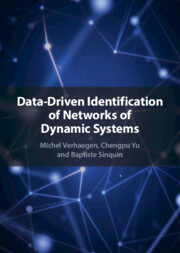Refine search
Actions for selected content:
1550 results in Control systems and optimization
1 - Singular Value Decomposition (SVD)
- from Part I - Dimensionality Reduction and Transforms
-
- Book:
- Data-Driven Science and Engineering
- Published online:
- 10 June 2022
- Print publication:
- 05 May 2022, pp 3-52
-
- Chapter
- Export citation
3 - Sparsity and Compressed Sensing
- from Part I - Dimensionality Reduction and Transforms
-
- Book:
- Data-Driven Science and Engineering
- Published online:
- 10 June 2022
- Print publication:
- 05 May 2022, pp 97-130
-
- Chapter
- Export citation
4 - Regression and Model Selection
- from Part II - Machine Learning and Data Analysis
-
- Book:
- Data-Driven Science and Engineering
- Published online:
- 10 June 2022
- Print publication:
- 05 May 2022, pp 133-167
-
- Chapter
- Export citation
8 - Linear Control Theory
- from Part III - Dynamics and Control
-
- Book:
- Data-Driven Science and Engineering
- Published online:
- 10 June 2022
- Print publication:
- 05 May 2022, pp 311-359
-
- Chapter
- Export citation
13 - Interpolation for Parametric Reduced-Order Models
- from Part IV - Advanced Data-Driven Modeling and Control
-
- Book:
- Data-Driven Science and Engineering
- Published online:
- 10 June 2022
- Print publication:
- 05 May 2022, pp 485-519
-
- Chapter
- Export citation
11 - Reinforcement Learning
- from Part IV - Advanced Data-Driven Modeling and Control
-
- Book:
- Data-Driven Science and Engineering
- Published online:
- 10 June 2022
- Print publication:
- 05 May 2022, pp 419-448
-
- Chapter
- Export citation
Part III - Dynamics and Control
-
- Book:
- Data-Driven Science and Engineering
- Published online:
- 10 June 2022
- Print publication:
- 05 May 2022, pp 251-252
-
- Chapter
- Export citation
14 - Physics-Informed Machine Learning
- from Part IV - Advanced Data-Driven Modeling and Control
-
- Book:
- Data-Driven Science and Engineering
- Published online:
- 10 June 2022
- Print publication:
- 05 May 2022, pp 520-541
-
- Chapter
- Export citation
Preface
-
- Book:
- Data-Driven Science and Engineering
- Published online:
- 10 June 2022
- Print publication:
- 05 May 2022, pp ix-xiii
-
- Chapter
- Export citation
Frontmatter
-
- Book:
- Data-Driven Science and Engineering
- Published online:
- 10 June 2022
- Print publication:
- 05 May 2022, pp i-iv
-
- Chapter
- Export citation

Data-Driven Identification of Networks of Dynamic Systems
-
- Published online:
- 28 April 2022
- Print publication:
- 12 May 2022
Frontmatter
-
- Book:
- Large-Scale System Analysis Under Uncertainty
- Published online:
- 17 January 2022
- Print publication:
- 17 February 2022, pp i-iv
-
- Chapter
- Export citation
8 - Discrete-Time Systems: Set-Theoretic Input Uncertainty
-
- Book:
- Large-Scale System Analysis Under Uncertainty
- Published online:
- 17 January 2022
- Print publication:
- 17 February 2022, pp 237-272
-
- Chapter
- Export citation
Preface and Acknowledgments
-
- Book:
- Large-Scale System Analysis Under Uncertainty
- Published online:
- 17 January 2022
- Print publication:
- 17 February 2022, pp xi-xii
-
- Chapter
- Export citation
2 - Preliminaries
-
- Book:
- Large-Scale System Analysis Under Uncertainty
- Published online:
- 17 January 2022
- Print publication:
- 17 February 2022, pp 16-53
-
- Chapter
- Export citation
Appendix B - Power Flow Modeling
-
- Book:
- Large-Scale System Analysis Under Uncertainty
- Published online:
- 17 January 2022
- Print publication:
- 17 February 2022, pp 320-329
-
- Chapter
- Export citation
Notation
-
- Book:
- Large-Scale System Analysis Under Uncertainty
- Published online:
- 17 January 2022
- Print publication:
- 17 February 2022, pp xiii-xvi
-
- Chapter
- Export citation
3 - Static Systems: Probabilistic Input Uncertainty
-
- Book:
- Large-Scale System Analysis Under Uncertainty
- Published online:
- 17 January 2022
- Print publication:
- 17 February 2022, pp 54-90
-
- Chapter
- Export citation
Appendix A - Mathematical Background
-
- Book:
- Large-Scale System Analysis Under Uncertainty
- Published online:
- 17 January 2022
- Print publication:
- 17 February 2022, pp 307-319
-
- Chapter
- Export citation
9 - Continuous-Time Systems: Set-Theoretic Input Uncertainty
-
- Book:
- Large-Scale System Analysis Under Uncertainty
- Published online:
- 17 January 2022
- Print publication:
- 17 February 2022, pp 273-306
-
- Chapter
- Export citation
